2 UNIT Diagnosis of abnormal behaviour.
1/67
Earn XP
Description and Tags
Diagnosis of abnormal behaviour.
Name | Mastery | Learn | Test | Matching | Spaced |
|---|
No study sessions yet.
68 Terms
The World Health Organization’s definition of health
a state of complete physical, mental and social well-being and not merely the absence of disease or infirmity.
Mental health
state of well-being
mental health let individuals
realize his or her own potential
cope with the normal stresses of life,
work productively
make a contribution to the community.
Mental health is related to
optimal development of the individual based on age, living conditions, & culture
cristicms of WHO definition of mental health
People in good MH are often sad, unwell, angry or unhappy, 6 this is part of a fully lived life for a human being.
many challenging life situations in which well-being may even be unhealthy
the equivalence between MH & well-being/functioning has not been accepted.
Working productively and fruitfully is often not possible for contextual reasons
several concerns when positive feelings and function are seen as factors for MH
components represented are not mandatory aspects - they may just contribute to the state of equlibrium
Mental health is
dynamic state of internal equilibrium - enables individuals to use their abilities in harmony with universal values of society.
Basic cognitive and social skills = ability to recognize, express and modulate one’s own emotions
empathize with others → flexibility and ability to cope & function in social roles
harmonious relationship between body and mind (internal equlibrium)
Dynamic state of internal equilibrium (mental health)
Different life epochs require changes in the achieved equilibrium
Mentally healthy people may experience appropriate human emotions while possessing sufficient resilience
Universal values
respect & care for oneself & other living beings (environment & freedom)
connectedness between people
Four perspectives from which you can understand the relationship between "normality" and "mental health”
Adjustment-maladjustment
Health-disease
Statistical normality-statistical abnormality
Welfare-discomfort
Adjustment-maladjustment
closely linked to reproduction (biological or social)
are of ideological, philosophical or religious nature.
Individuals must confirm to universal rules
Normal: who adjusts to the dominant rules/ does not show serious problems/ does not give serious problems → if not? abnormal
Interventions aim to achieve the adaptation through educational-instructional strategies or of restrictive type
Health-disease
Linked to a biomedical perspective
human seen as organismic machine that will break down as alteration of functional type because of some external entity
universal & objective existence of the disease defined as diagnosable entity intervented though standardized ideal method
Nosotaxies describes → diagnostic criteria by which one can determine the existence of some kind of disease
Biological or neuro-biochemistry alteration
psychopharmacology as basic treatment
Nosotaxies describes
diagnostic criteria by which one can determine the existence of some kind of disease
Statistical normality-statistical abnormality
statistical perspective → mathematical criteria
explains mental health through placement of individuals with regards to means and standard deviations
behaviour is determined within expected ranges (social perspective) or scientifically defined (health perspective)
the behaviour that frequently occur in a population are normal / infrequent behaviour is abnormal
impact individuals through normalization strategies determined by the mean - diminishment in prevalence and incidences
Welfare-discomfort
Broad anthropologic view
mental health is existential, subjective & ideographic concept
assessment that the subject makes of his life through hedonic view (seeking pleasure, avoidance of suffering) or eudaimonic (realization of virtue)
Welfare allows the subject to be
a subjective experience of intrapersonal, interpersonal, social & environmental integration.
suffering + displeasure is indicated as rupture to the subject himself
Interventions of welfare-discomfort intended to
build an individual happily integration with himself → enthusiastic, efficient, productive, with initiative & imagination, spontaneous, calm & free.
concepts of normality & abnormality
failure to function adequately
deviation from ideal mental health
statistical infrequency
deviation from social norms
the mental illness criteria
The relationship between mental health and normality
not possible to think of an unambiguous relationship between normality & mental health
multiple meanings determined by factors that are of contextual, historical, political, economic & cultural nature.
includes different anthropological & epistemological elements
distinct conceptual possibilities & radically different interventions.
The Illness-Wellness Continuum
states that many degrees of wellness as well as illness → neutral point in the middle
different degrees of health → people move on a continuum ranging from great to illness or disability.
e.g. many fall somewhere in the middle, they’re generally in good health, with occasional problems
neutral point in the middle of Illness-Wellness Continuum
no visible illness
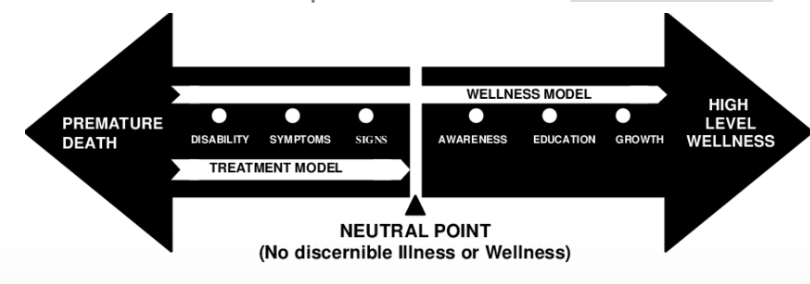
Wellness
is a dynamic process
impacted by the active pursuit of activities, choices & lifestyles that lead to a state of holistic health.
mental health continuum model
everyone has mental health
mental well-being: emotions, thoughts, problem-solving ability
In the course of a lifetime - Mental health
Some people will experience mental illness
Everyone will struggle or have a challenge with their mental well-being
Abnormal behaviour
does not necessarily indicate mental illness
The mental health continuum model photo
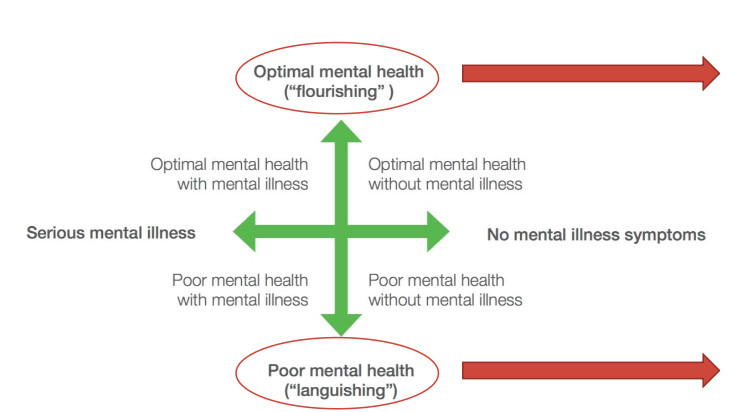
mental health continuum model
Mental well-being can also be plotted along a vertical line or a continuum → reflects the whole range of experiences related to mental well-being
top of the line → flourishing or thriving
bottom of the line → languishing or, simply, surviving
the bottom is reflecting feelings of emptiness, loneliness and lack of vitality
optimal mental health + no mental illness symptom
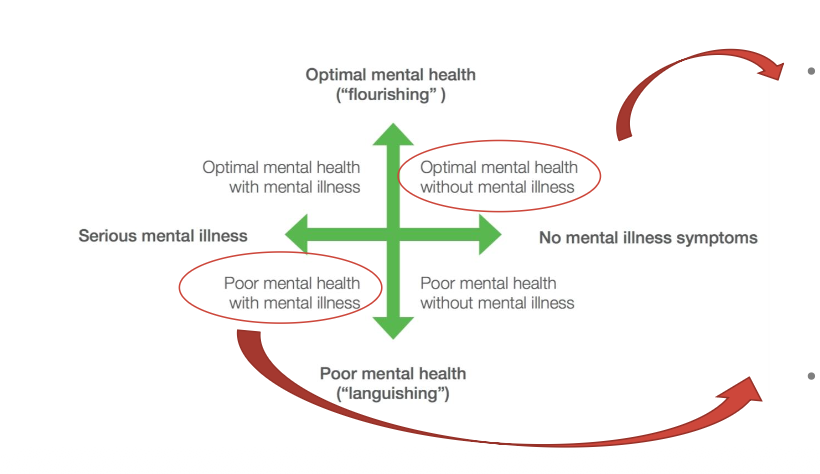
People can be flourishing in absence of symptoms of mental illness
poor mental health + serious mental illness
Individuals might show poor mental health when struggling with mental illness
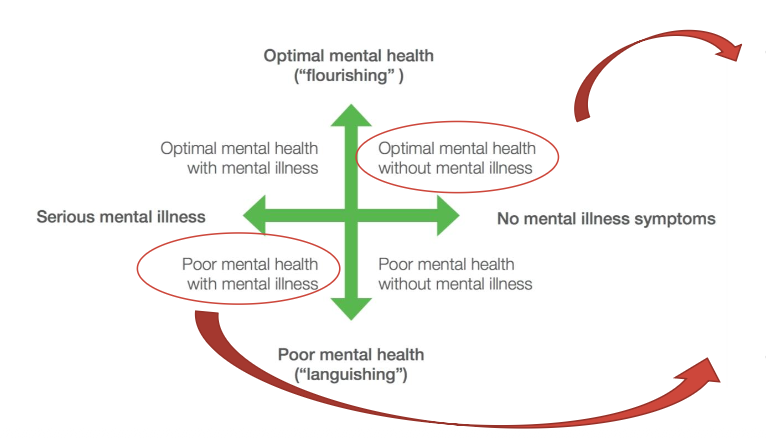
Serious mental illness + optimal mental health (flourishing)
Possible to be flourishing with symptoms of a serious mental illness.
It is possible to have mental health having a mental disorder (feel well despite suffering from any clinical condition).
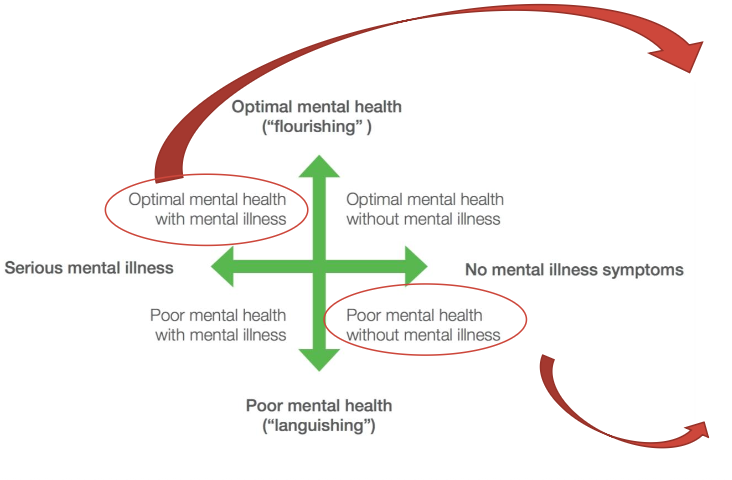
Poor mental health (languishing) + no mental illness symptoms
possible to be languishing without symptoms of a serious mental illness.
→ have poor mental health without a diagnosis/ in absence of mental illness.
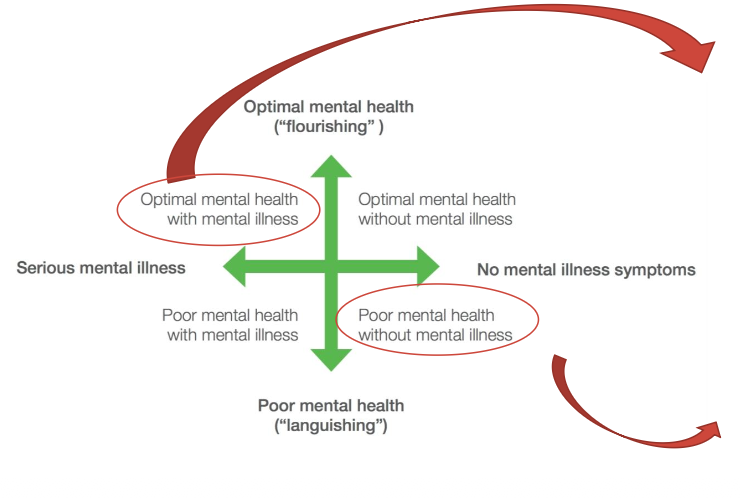
The mental health continuum model photo of possibilities
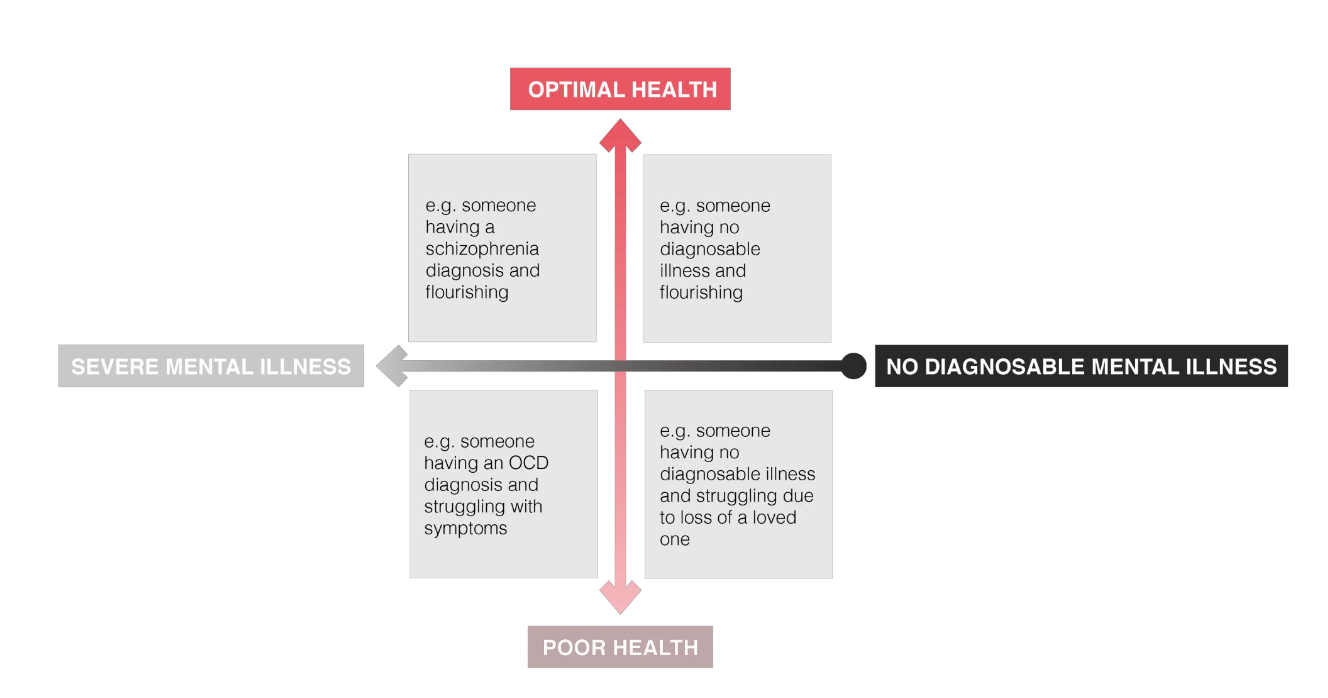
important part of good mental health
ability to look at problems or concerns realistically
living & coping well despite problems.
Mental illnesses are often
episodic → times of ill, & times of better health
Mental illness can affect
anyone, at any time—& each person responds to it differently.
does seem to impact certain groups of people more often:
women
youth
disabilities/chronic illnesses
refugees
aborginal people
With right support & tools
anyone can live well
different kind of mental illnesses
each one can cause different symptoms or affect someone’s life in very different ways.
affecting a person´s emotions, thoughts & behaviours (how they view; themselves, others & their interaction)
What makes a condition as an illness
duration & impact on life
4 basic dimensions of mental health & well-being
thoughts, emotions, behaviours & body reactions → holistic interplay
thoughts dimension
the way we think something has a big impact on mental health
body reaction dimention
changes in body functions → heart-rate, breathing, digestion, brain chemicals, hormones
Behaviour dimension
helpful & harmful actions
observable
emotions dimensions
the way someone feels
pleasant & unpleasant
Mental disorders comprise
a broad range of problems with different symptoms
many of them can be successfully treated
Characteristics of mental disorders
combination of disturbed thoughts, emotions, behaviour & relationships with others.
examples of mental disorders
depression
anxiety
conduct disorders in children
bipolar disorders
schizophrenia
According to DSM-5 - a mental disorder is
syndrome
characterized; clinically significant alteration of an individual's cognitive state, emotional regulation or behaviour
reflecting → dysfunction in the psychological, biological or developmental processes underlying mental functioning.
according to DSM-5 - mental disorder is Usually associated with
significant distress in social, occupational, or other important activities.
not defined as mental disorders related to DSM-5
expectable or culturally approved response to a common stressor or loss (death)
Socially deviant behaviour (political, religious) conflicts that are primarily between the individual & society [unless, deviance or conflicts results from dysfunction]
Criteria for defining mental disorders
Psychological dysfunction leading to distress, impairment in functioning, deviant (not typical/cultural expected)
Patterns of thoughts, feelings, or actions are deviant, distressful, & dysfunctional
Patterns refers to
collection of symptoms
clinically significant
Symptoms that are severe enough to interfere with a person's daily life
The 5 D´s in psychopathology
Distress
Dysfunction
Deviance
Danger
Duration
Distress
Existence of marked personal suffering/ extreme anguish or pain
the individual is extremely upset
extent to issue distresses the individual
distress in extreme cases can lead to
suicide
is distress a psychopathological condition?
no sufficient condition
!!!only a Necessary condition !!!
why is distress only a NECESSARY condition in psychopathological condition
Suffering is inevitable & inherited experience
Some disorders do not cause the perception of suffering in one's own → thus, distress is missing
Distress: an example
Hypochondriasis
Hypochondriasis
preoccupation with the fear of having idea of a serious disease, based on the misinterpretation of an individual’s bodily symptoms
somatoform disorder → elements of anxiety disorder
more medical resources compared to term of their prognoses
How to treat Hypochondriasis
Effective treatments all centred on decreasing the amount of distress experienced by the individual with the disorder
one can lower the anxiety and distress level, a positive outcome may be more likely.
Dysfunction
Impact on a person’s ability to manage day-to-day tasks & relationships.
significant
interfere in the individual’s life in some major way, & across different life domains.
Example of dysfunction
severe depression or anxiety → prevent from going to work/ school
Major Depressive Disorder, Recurrent, without Psychotic Features
characterized by 2 or more episodes of MDD
symptoms related to dysfunction in MDD
negative impact (dysfunction) in multiple areas of the individual’s life.
impact relationships with others negatively
decrease in pleasure in almost all of the activities of life
insomia (sleeping issue) affecting daily tasks
nergy loss and lack of motivation to do common tasks, e.g. personal hygiene
Interfere ability to complete tasks at home and work.
What makes the individuals condition dysfunctional?
experience some dysfunction in almost every area of life & severe dysfunction in many areas.
increased number of sick days
women with depression & their children
Children have higher rates of dysfunction in school, less socially competent, lower self-esteem
Leading cause of disability among people 18 to 44 years
depression
relationship between distress & dysfunction
not always linear,
they don’t necessarily happen together
possible → great deal of dysfunction and very little distress or
vice versa.
Deviance
Atypical or not culturally accepted/ expected.
Differing from the social norm/ deviated from the average or what is frequent or a typical developmental pathway.